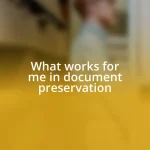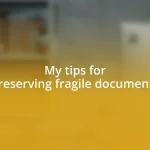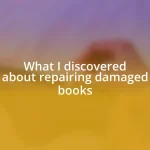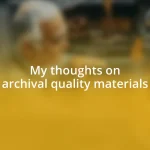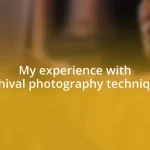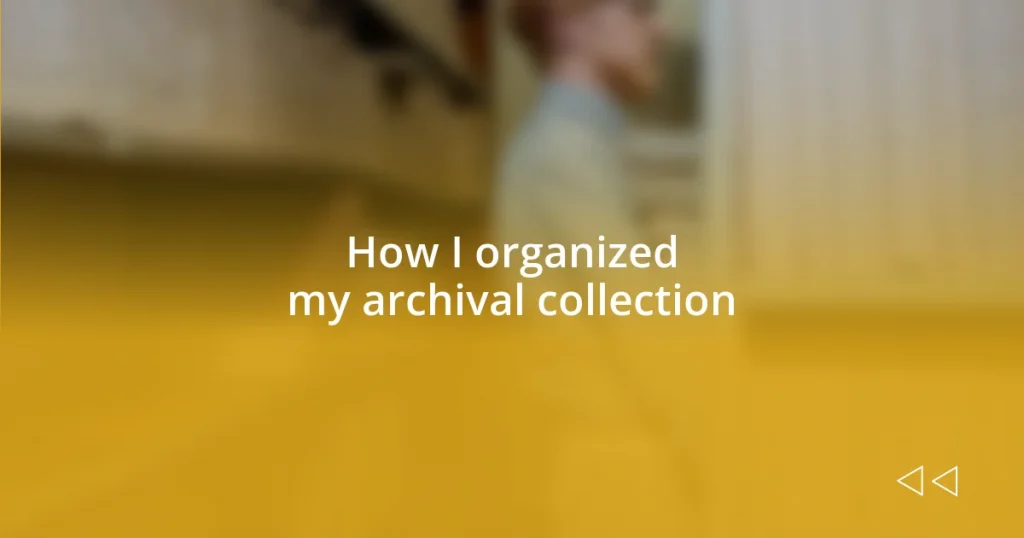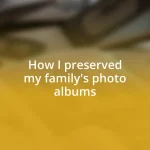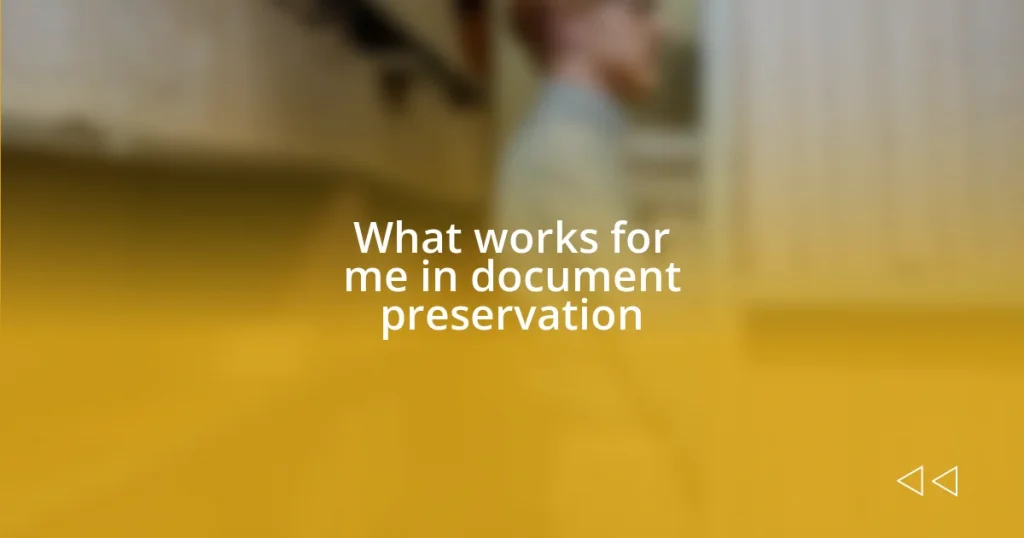Key takeaways:
- Assessing archival needs requires introspection to prioritize emotionally and historically significant items while considering practical preservation factors like storage and care.
- Implementing a digital management system enhances organization by allowing easy cataloging, retrieval, and backup of collection items, fostering emotional connections with memories.
- Sharing the collection fosters community connections, sparks conversation, and can inspire future generations to appreciate and preserve their own histories.
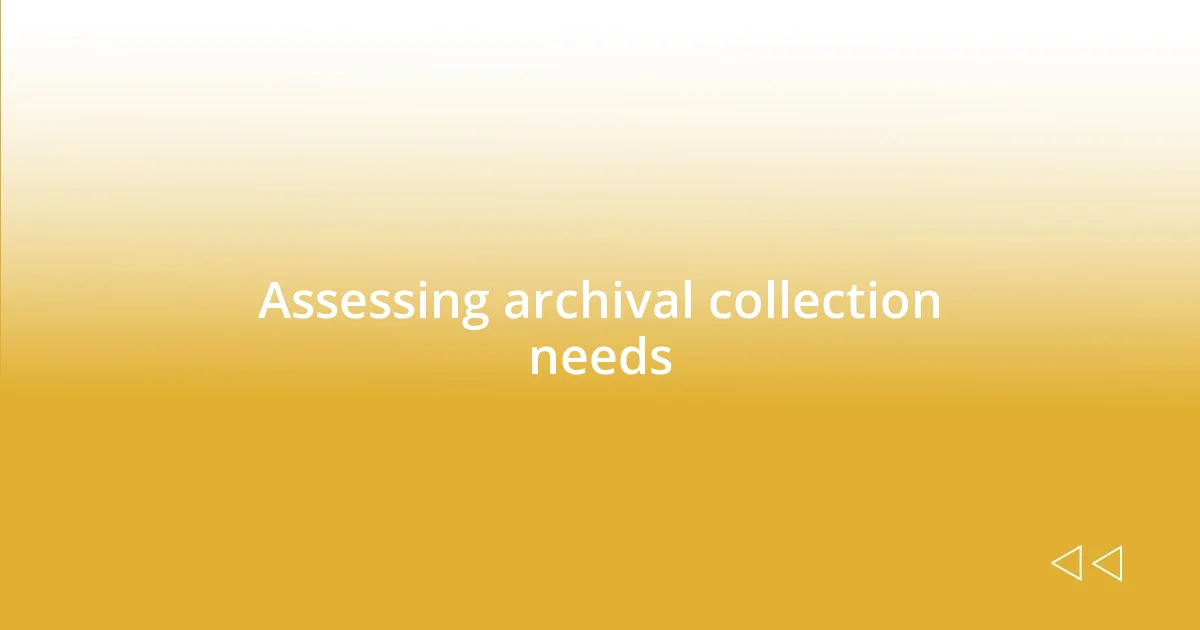
Assessing archival collection needs
Assessing the needs of an archival collection starts with a clear understanding of what I aim to preserve. When I began my own collection, I took a step back to consider not just what I had, but what was truly valuable to me — both emotionally and historically. Would these items tell a story in the future?
I remember sitting down with a cup of tea surrounded by boxes of memories: photographs, letters, and keepsakes. It struck me how easily I could get lost in the sheer volume of it all. I had to ask myself, which pieces truly captured significant moments in my life? This kind of introspection helped me prioritize what to keep and what could be let go.
As I organized my collection, I realized that assessing needs also meant considering the practical aspects—like storage space and climate control. It’s key to think about how the collection will be maintained. Will I have the time and resources to care for it properly? Balancing emotional attachment with practical preservation needs can truly enhance the archival experience.
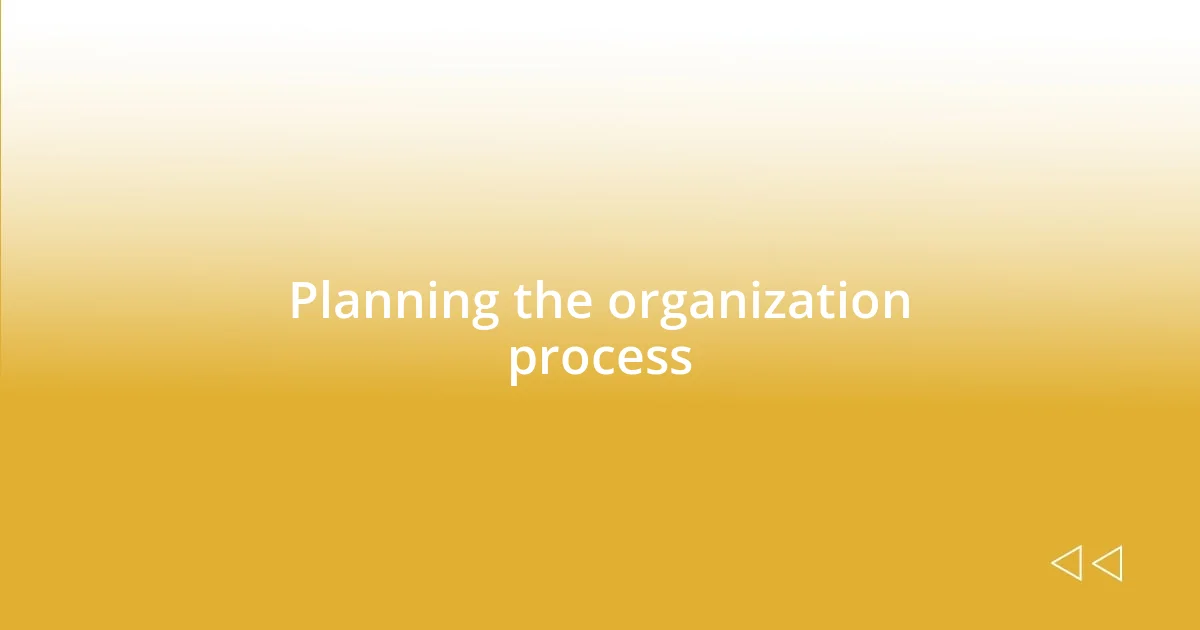
Planning the organization process
When I planned my archival organization process, I realized that clarity was essential. I created a detailed outline that mapped out the various categories I wanted to use, like “Family History,” “Travel Memories,” and “Personal Milestones.” This organization helped ensure that every item had a designated place, making retrieval much simpler later on.
Putting together a timeline for when I hoped to complete specific tasks also proved invaluable. By breaking down the organization into manageable chunks, like focusing on one category at a time, I avoided the feeling of being overwhelmed. I remember spending an entire weekend on just my family photographs—sorting through years of snapshots was a nostalgic trip down memory lane that brought both joy and insight into the importance of careful arrangement.
One practical tool that I found useful was a checklist—something that kept my motivations in line and my progress visible. Each category I tackled felt like a small victory, and crossing items off the list was not only satisfying but encouraged me to keep moving forward. Seeing how all the pieces fit together was like piecing together a puzzle of my life.
| Planning Aspect | My Approach |
|---|---|
| Organization Categories | Defined clear categories, such as “Family History” and “Travel Memories” to streamline the sorting process. |
| Timeline | Set a realistic timeline for completing different sections, helping prevent overwhelm. |
| Progress Tracking | Utilized a checklist to track progress, keeping motivation high and celebrating small victories. |
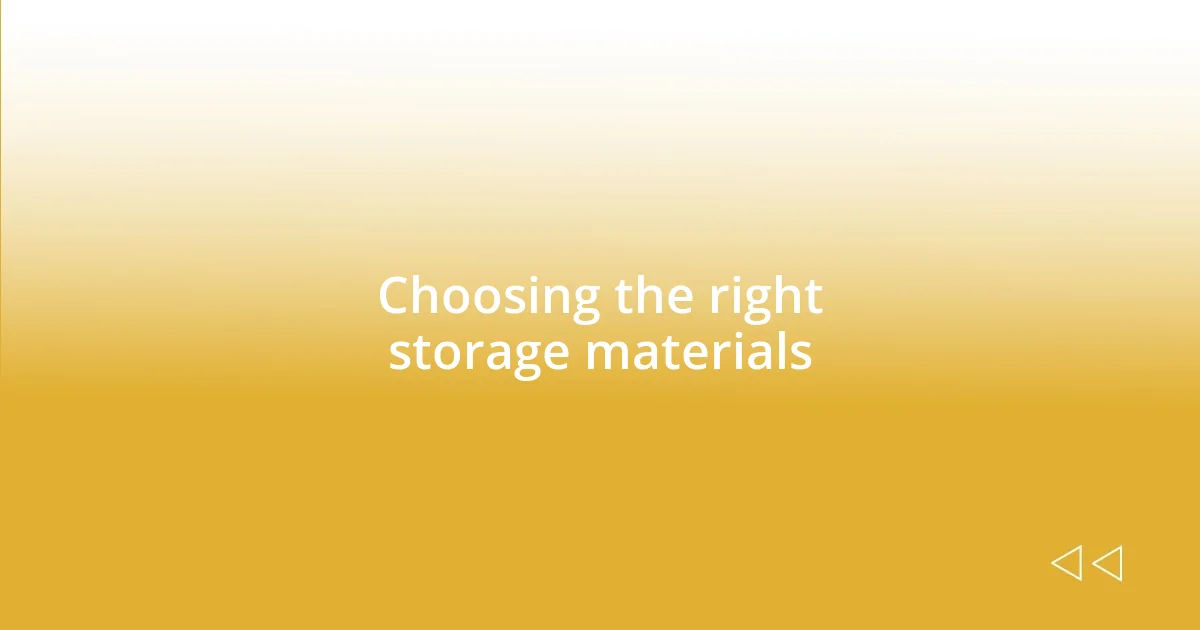
Choosing the right storage materials
Choosing the right storage materials is crucial for preserving the integrity of my archival collection. As I embarked on this journey, I quickly learned that not all materials are created equal. I decided to invest in archival-quality containers that would protect my treasures from light, dust, and moisture. While some items might seem sturdy, I discovered that using non-archival materials can lead to deterioration over time. I remember the disappointment of finding a beloved photograph showing signs of fading because I hadn’t chosen the right protective sleeves. That experience reinforced the importance of choosing materials designed specifically for archival storage.
Here are some storage materials that I found essential:
- Archival Boxes: Made from acid-free materials, they prevent degradation of photographs and documents.
- Mylar Sleeves: Great for individual items like letters or photos; they’re transparent and strong, allowing safe visibility.
- Acid-Free Paper: Useful for interleaving or wrapping fragile documents, keeping them from sticking together.
- Humidity Control Packs: These help maintain the right conditions in storage areas, protecting against moisture damage.
- Labeling Materials: Acid-free labels or pens ensure I can clearly identify items without causing harm.
Choosing materials may seem like a small detail, but it can make all the difference in how my collection endures. I’ve found that each carefully chosen item adds a level of security, allowing me to cherish my memories without the lingering worry of their loss.
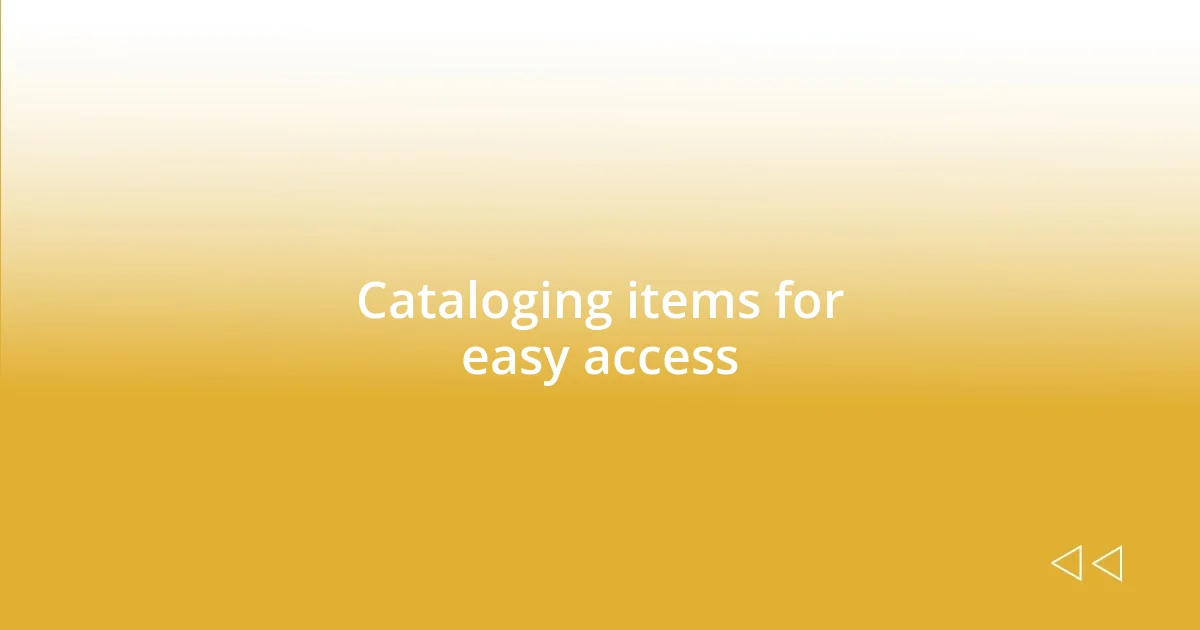
Cataloging items for easy access
Cataloging is where my archival journey truly took shape. I remember my excitement when I first sat down with a notebook, thrilled at the possibility of creating a comprehensive inventory. By initially dividing items into broad categories, I found it much easier to assign detailed labels to specific pieces. For instance, creating a subcategory for “Letters” within “Family History” allowed me to pinpoint correspondence from my grandmother with just a glance. Isn’t it fascinating how something as simple as a label can evoke so many memories so quickly?
As I cataloged my collection, I discovered the power of a digital approach. I started using spreadsheet software to input details about each item, including date, description, and condition. I can’t emphasize enough how this method enhanced my efficiency. With just a few clicks, I could filter to find everything related to, say, a particular family trip. The joy of unearthing a long-lost travel diary while casually browsing my spreadsheet was nothing short of exhilarating. Not to mention, this digital tag-along became a secure backup, a reassuring thought in our fast-paced, technology-driven world.
Finally, I added descriptive tags that captured the essence of each item—like my mother’s laughter echoed in a photograph from her wedding day. It made me wonder: how often do we overlook the narratives behind our collections? By documenting those little details, I created a more vivid picture of my life’s chapters. Now, when I pull out an item to share with family, it’s not just a piece of paper or a photograph—it’s a gateway to a story that connects us all.
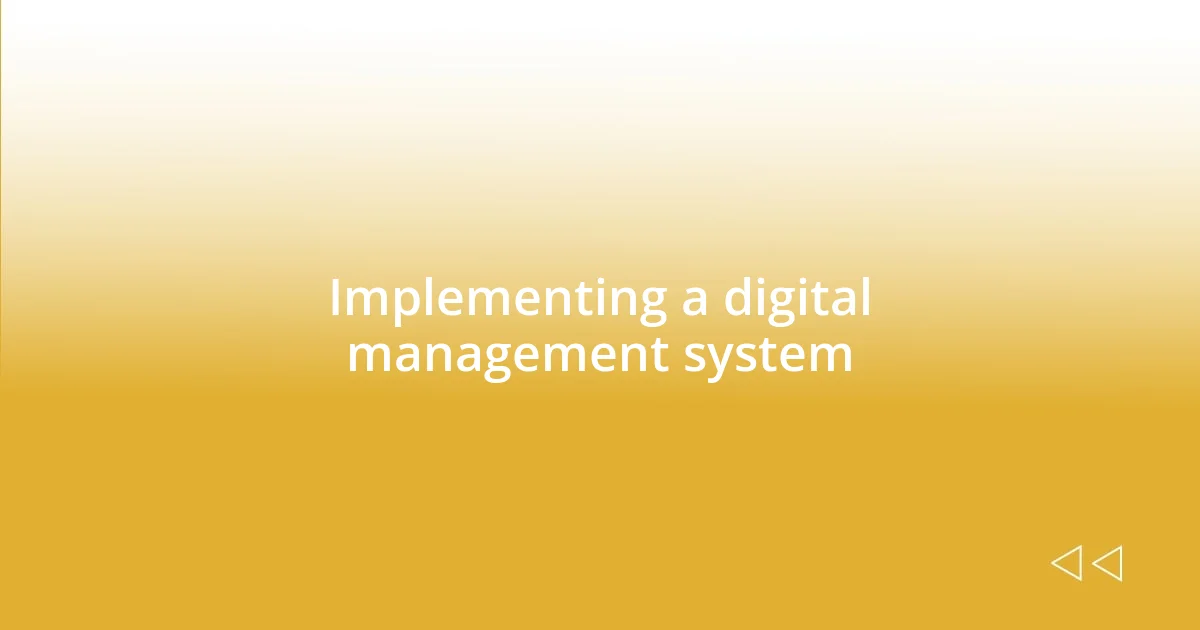
Implementing a digital management system
Implementing a digital management system was a game-changer for me. Initially, I felt overwhelmed by the sheer volume of items in my collection, but then I realized that technology could simplify the chaos. I opted for a digital management software designed specifically for archival collections, allowing me to categorize, search, and retrieve items effortlessly. Can you imagine the relief I felt when I no longer had to sift through physical boxes just to find an old letter? It transformed my entire process.
As I started to delve into this new digital realm, I found myself immersed in the features offered by the software. For example, incorporating photographs of each item directly into the database allowed me to visualize my collection in a way that mere text could never convey. It brought a vibrant element to my cataloging efforts. I still recall the joy of clicking through my digital gallery, each thumbnail a portal to cherished memories. It’s fascinating how technology can create such a strong emotional connection!
Moreover, the cloud storage feature played a critical role in safeguarding my collection. Knowing that my items were backed up securely provided a comforting sense of security. When I faced a home renovation and had to temporarily relocate my archival materials, the thought of losing them was terrifying. However, with the digital management system, I realized I could access everything remotely. How comforting is that, knowing that distance doesn’t diminish the value of those memories? It truly felt like I had crafted a resilient lifeline to my past.
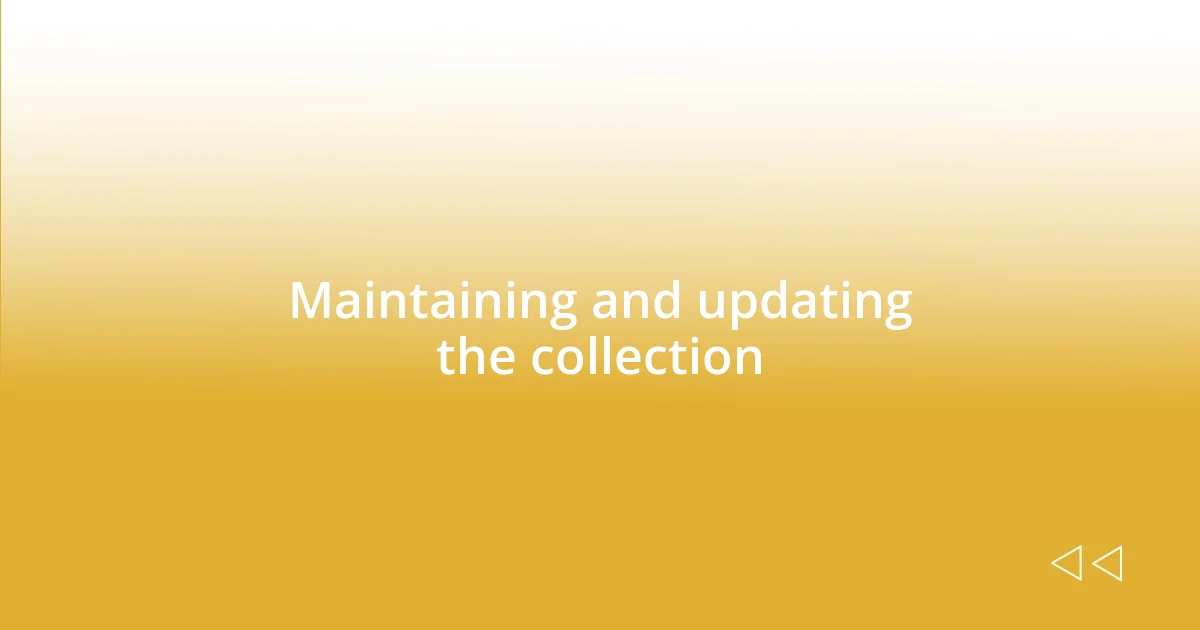
Maintaining and updating the collection
Maintaining my archival collection has turned into a rewarding routine that I truly cherish. I make it a point to schedule dedicated time each month to review and update my inventory. It’s during these moments that I stumble upon forgotten treasures, like a charming postcard from a childhood friend, and I can’t help but reminisce about those carefree days. Hasn’t nostalgia got a way of sneaking up on you when you least expect it?
Whenever I acquire new items, I’ve established a habit of immediately cataloging them. This practice prevents the collection from becoming overwhelming again. I vividly remember coming back from a family reunion with a handful of photographs that needed to be documented. By taking the time to label and categorize them right away, I ensured those memories were preserved in the same organized manner as the rest of my collection. It feels satisfying to keep each addition orderly, preserving not just the items, but the stories they tell.
Staying engaged with my collection has also encouraged me to share it with others more often. When I invite friends or family over, I pull out specific items that speak volumes about our shared history. It sparks conversations that may never have happened otherwise. I love hearing their stories and seeing their reactions when they discover a piece of our past they’d forgotten or never knew about. Isn’t it amazing how memories can connect us all in such a profound way?
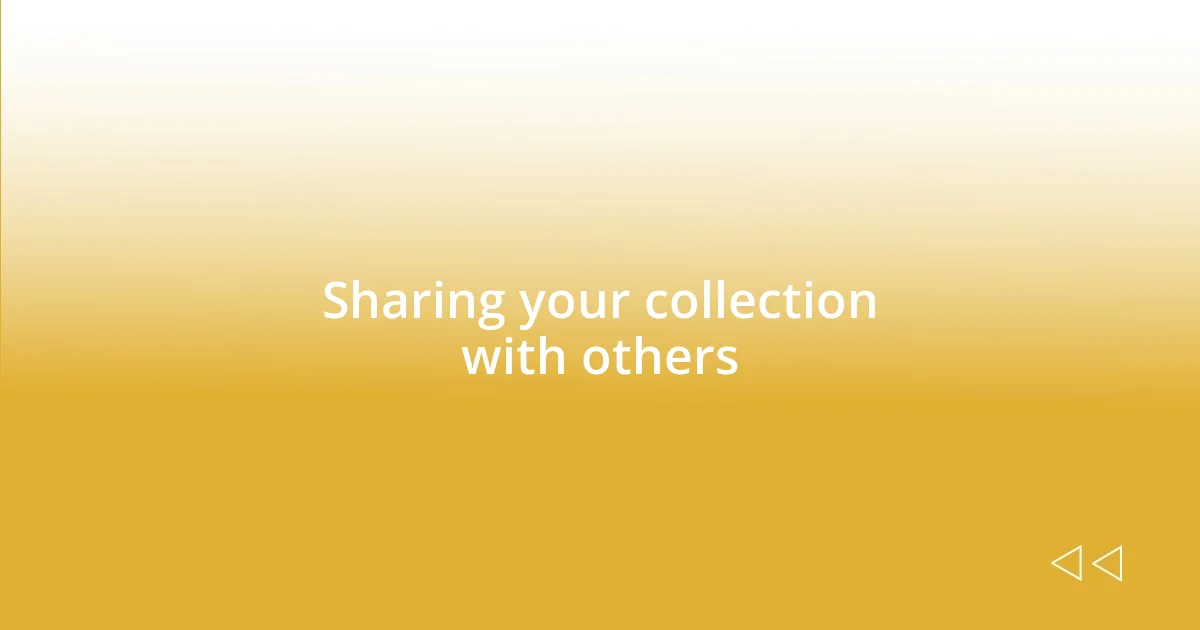
Sharing your collection with others
There’s something deeply fulfilling about sharing my archival collection with others. I recall one afternoon hosting a casual gathering where I pulled out an old journal filled with my grandmother’s stories. As I flipped through the pages, the room turned silent, with everyone leaning in to catch a glimpse of her handwritten words. It’s moments like these that make me realize how powerful sharing can be. Have you ever felt that sense of unity when revealing a piece of family history that others can connect with?
I also enjoy participating in local history forums and social media groups. When I share photos and snippets from my collection, it often ignites conversations with individuals who have similar interests. One post showcasing a vintage ticket stub led me to connect with a fellow enthusiast who was able to share insights about the event itself. Isn’t it remarkable how sharing our collections can bridge gaps between strangers, creating a sense of community around shared interests?
Additionally, I’ve started partnering with local schools for projects that utilize my collection. I was once invited to present my items to a class, and seeing the students’ eyes light up as they grasped a piece of the past was incredibly rewarding. It sparked a valuable discussion not just about history, but also about the importance of preserving personal narratives. How gratifying it is to know that sharing can inspire the next generation to value their own stories and collections!

